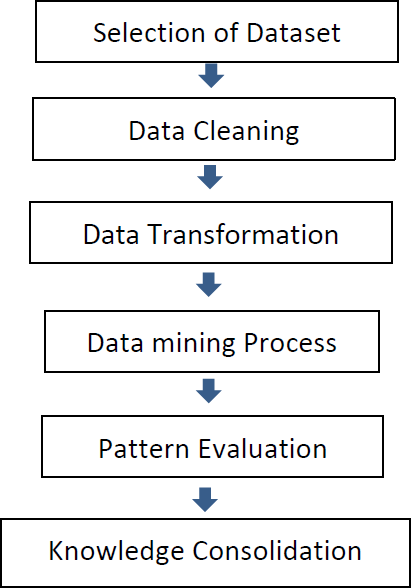Translate this page into:
Data Mining: A Medical Perspective
CORRESPONDING AUTHOR: Gothai Nachiyar S, Bio-Statistician, Department of Community Medicine, Bhaarath Medical College & Hospital, BIHER University, Chennai -600073, Chengelpet District, Tamil Nadu. E Mail ID: gothaistat@gmail.com
-
Received: ,
Accepted: ,
CITATION: Gothai NS, Kalaivani A, Sharath U. Data Mining:A Medical Perspective. J Comp Health. 2023;11(1):13-14. Doi: https://doi.org/10.53553/JCH.v11i01.003
Abstract
Data mining is the process of identifying patterns, anomalies, and correlations in huge databases that may be used to forecast future trends. It is also known as data knowledge discovery (KDD). The future of healthcare may hinge on the use of data mining to improve public health while also lowering health-care costs, saving time, identifying treatment plans and best practises, measuring effectiveness, detecting fraudulent insurance and medical claims, and ultimately improving patient standards. Data mining is important in the healthcare sector because, as people's lives change, various diseases impact them, and there is a need to utilise an efficient technique to anticipate the disease in time so that suitable treatment may be delivered to the patient. The quantity &quality of many health care interventions are improved through results of data mining, such as advanced through medical model of health which focuses one radication of illness through diagnosis & effective treatment.
INTRODUCTION
“Data Mining (DM) is the investigation of massive databases to uncover hidden and previously unknown patterns, correlations, and information that are difficult to detect using traditional statistics” [1]. Data mining is the process of identifying patterns, anomalies, and correlations in huge databases that may be used to forecast future trends. Data mining, also known as data knowledge discovery (KDD). Data mining algorithm(s) aid in the automation of data extraction, which aids in the acquisition of interesting knowledge. Knowledge Discovery in Databases (KDD) refers to the broad process of discovering knowledge in data and emphasises the “high-level” application of specific DM techniques [2]. The KDD process is collaborative and continuous, with many stages depicted in figure 1.

Data mining in Healthcare
Health-care organisations routinely gather and store massive volumes of data. Healthcare is a knowledge-rich industry; data mining is becoming a requirement [2], and it has been ingrained in the industry for many years. Healthcare data mining provides an infinite number of opportunities for detecting unknown trends in data sets. Data mining is significant in healthcare because it allows individuals to see data in new ways and identify patterns, trends, and relationships that may be used to forecast future events and other things. The future of healthcare may hinge on the use of data mining to improve public health while also lowering health-care costs, saving time, identifying treatment plans and best practises, measuring effectiveness, detecting fraudulent insurance and medical claims, and ultimately improving patient standards [5]. Data mining can even match patients with doctors based on reports of successful diagnostic rates, and it aids in the preparation of Health Care Information System (HMIS) reports for the utilisation of hospital capacities such as the number of occupied and vacant beds, the number of patients vs doctors and nurses, and so on. Hospitals and clinics can enhance patient outcomes and safety while cutting costs and response times.
Application of Data mining
The application of data mining in healthcare is comparing and contrasting symptoms, causes, and treatment options in order to determine the best successful course of action for a certain illness or condition. Patient groups treated with different drug regimens, for example, might be compared to identify which treatment strategies work best and save the most money. Furthermore, ongoing use of this data mining tool may aid in standardising a technique of therapy for a given ailment, making the diagnostic and treatment process faster and easier. Data mining applications in healthcare could be divided into major areas for examination.
Data mining Techniques
The usage of data mining techniques on medical data is exploding for discovering useful information that can be used in strategic planning and identification. Classification, clustering, regression, association rule mining, classification and regression tree (CART), Nave Bayes, support vector machine (SVM), decision tree, and neural networks are the most extensive data mining techniques utilised in the healthcare domain. The main purpose here is to value data mining methodologies required for medical data mining, namely to evaluate local common diseases such as heart illnesses, breast cancer, lung cancer, and so on. Medical data mining is still a popular field, notably in the detection of heart disease; in fact, many researchers are working hard to enhance medical decision support systems to assist physicians. Data mining is important in the healthcare sector because, as people's lives change, various diseases impact them, and there is a need to utilise an efficient technique to anticipate the disease in time so that suitable treatment may be delivered to the patient.
CONCLUSION
Data mining is the process of uncovering innovative, interesting, and potentially useful patterns in data and applying algorithms to extract hidden information. The quantity &quality of many health care interventions are improved through results of data mining, such as advanced through medical model of health which focuses one radication of illness through diagnosis & effective treatment.
References
- “One Dependency Augmented Naïve Bayes”, In Proc. 1st Int'l Conf. Advance Data Mining and applications (ADMA), pp.186-194 (2005)
- [CrossRef] [Google Scholar]
- “ A Primer on Data Mining in Perspective of Healthcare Sector” In Kala sarovar (UGC Care Group-1 Journal) Vol-23No.02(II) November-December (2020)
- [Google Scholar]
- Mehmet Akif CIFCI, Sadiq Hussain “Data Mining Usage and Applications in Health Services”, International Journal On Informatics Visualization, VOL 2 NO 4 (2018)
- [CrossRef] [Google Scholar]
- Dr. Surendra Kumar Yadav, Nitesh Dugar, Aditi Jain “Future Perception In Public Health Care Using Data Mining” International Journal of Engineering Research & Technology (IJERT) Vol. 3 Issue 1, January (2014)
- [Google Scholar]
- Milovic Boris and Milovic Milan “Prediction and Decision Making in Health Care using Data Mining”, International Journal of Public Health Science (IJPHS), 1(2), pp. 69-78, (2012)
- [CrossRef] [Google Scholar]





